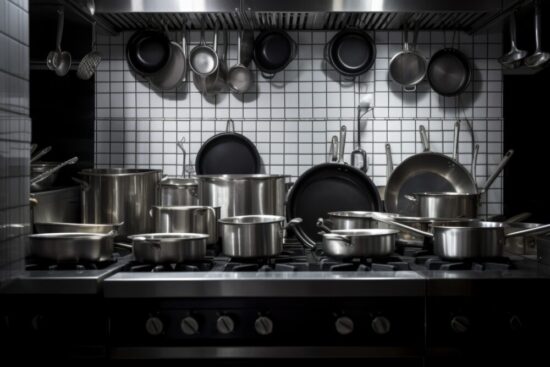
When you’re preparing to buy a new pan, ensuring you choose the right type of cookware is a must. For many people, deciding between stainless steel and non-stick cookware seems like a challenge. However, there are benefits to stainless steel pans that are worth considering. Here are ten advantages of stainless steel pans vs. non-stick pans to keep in mind.
1. Long-Term Durability
With a stainless steel pan, you get long-term durability. Typically, you don’t have to worry about rust at all. Plus, there’s no coating that could get scraped off over time. Considering that consuming scratched-off coatings isn’t great from a health perspective, that alone can cause many people to choose a stainless steel pan over a non-stick alternative.
Stainless steel also resists scratching and staining. As a result, it’s easier to keep your cookware looking its best for years. In most cases, stainless steel cookware is also dishwasher safe, so you don’t have to worry about the dishwasher causing any harm. Just make sure that the handle material offers a similar level of durability. Otherwise, the handle may not last as long as the pan, which can be disappointing.
2. Better Searing and Browning
Many cooks feel that stainless steel outperforms non-stick cookware when it comes to searing. Additionally, they believe that stainless steel is better at browning meats. One reason could be that stainless steel cookware is highly conductive, which can lead to better heat distribution.
3. Oven and Broiler Safe
When you choose a stainless steel pan, you get versatile cookware. Since there are no coatings, many stainless steel pans can safely transition from the stovetop to the oven. Baking and broiling to temperatures as high as 600°F could be possible, depending on the manufacturer’s recommendation.
One critical point to consider when selecting a stainless steel pan if you want to use it in this manner is the handle material. Not all handle materials are as heat-tolerant as stainless steel, so make sure you select cookware with a handle material that can stand up to baking or broiling before using it in an oven.
4. More Cooking Utensil Options
Non-stick cookware has coatings that create a non-stick surface. As a result, you usually shouldn’t use metal cooking utensils as they can damage the coating.
With stainless steel pans, using metal utensils to cook isn’t usually problematic. As long as it’s not overly abrasive or sharp – as it is possible to scratch stainless steel – you’re generally in safe territory.
5. Works Well for Acidic Ingredients
The coating on non-stick pans can break down if you use acidic ingredients regularly, shortening the life of your cookware. While some metals may react in the presence of acidic ingredients, too, that won’t happen with stainless steel. That makes it an excellent choice if you enjoy cooking with citrus or vinegar, as well as if you make tomato sauces or other classically acidic meal components.
6. Excellent for Sautéing
When you need to sauté vegetables or other ingredients, stainless steel is a better choice than non-stick. Sautéing requires high heat, and most non-stick pans aren’t designed to safely withstand the required temperature. With stainless steel, high heat isn’t an issue, making it the go-to option when you want to sauté your ingredients.
7. Toxin-Free
As mentioned previously, non-stick coatings may not contain the safest materials. If a non-stick pan is heated too much or the coating starts breaking down, it can release harmful chemicals into the air or your food. With stainless steel, that isn’t a concern, as there are no chemical-based coatings involved.
8. Easy to Disinfect
While cleaning up stainless steel pans may require a bit more elbow grease in some cases, disinfecting is simple. The surface is inherently nonporous, so there’s less chance of bacteria or contaminant buildup. That can make stainless steel a safer option if you’re concerned about germs when compared to some alternatives.
9. Excellent Value
In many cases, a stainless steel pan requires a bit of an investment. However, it’s usually worth the money. Stainless steel cookware can last far longer than many alternatives, including when compared to non-stick pans. So, by paying more initially, you can spend less long-term, as you won’t have to replace your stainless steel pan any time in the near future.
10. Stainless Steel Can Be Non-Stick
While it may come as a surprise to many, stainless steel cookware can actually be non-stick. Generally, it requires a highly polished surface to achieve this benefit, so it can mean having to invest in top-quality stainless steel pans. Still, if you decide to go that route and care for the stainless steel pan properly, food sticking may not be as much of an issue as you would expect.
Plus, you can make stainless steel function as a non-stick pan, even if it isn’t highly polished. In many cases, heating the pan up with oil or butter before adding any ingredients can prevent food from sticking, making cleanup easier to manage.
Do you know of any other advantages of choosing a stainless steel pan over non-stick? Share your thoughts in the comments below.
Read More:
- Here Are the Most Useful Kitchen Gadgets Under $10 On Amazon
- 7 Simple Appliance Maintenance Tips to Avoid Costly Repairs
- How to Upgrade Your Kitchen on a Budget
Come back to what you love! Dollardig.com is the most reliable cash back site on the web. Just sign up, click, shop and get full cash back!
Tamila McDonald is a U.S. Army veteran with 20 years of service, including five years as a military financial advisor. After retiring from the Army, she spent eight years as an AFCPE-certified personal financial advisor for wounded warriors and their families. Now she writes about personal finance and benefits programs for numerous financial websites.
Comments